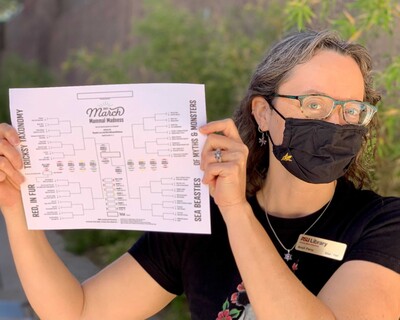
Equipped with brackets, tournament rounds and live commentary via Twitter, the annual NCAA-inspired tournament created in 2013 by Katie Hinde, an associate professor in the School of Human Evolution and Social Change, is now fully accessible via the library guide created by ASU Scholarly Communications Librarian Anali Perry.
Here to talk about the library’s growing role in the tournament, Perry says that March Mammal Madness (MMM) is a good example of innovative and open scholarship.
Question: Why is the library guide now the official MMM home?
Perry: This year, we made the Library Guide the official and primary launching point for MMM, because it is more functional than a personal blog, and presents as a much more recognizable educational platform for educators. The library guide makes it easy to find information about how to play, suggestions for freely available and librarian-approved places to research your bracket (beyond Wikipedia, which is awesome, but could be subject to manipulation), and an organized place to get brackets, resources, relevant links, and most importantly, BATTLE RESULTS!
Q: The library guide you created is the most viewed guide at the ASU Library. Can you talk about the impact and reach of the tournament?
Perry: So far, the library guide has received over 395,000 views this year. In fact, in 2019, we learned that the March Mammal Madness Library Guide is in the top 1.74% of all library guides in the world! And we know that 5,400 educators said they will be using March Mammal Madness in the classroom, which means the tournament will be reaching about 440,000 learners.
Q: How is the tournament a good example of innovative and open scholarship?
Perry: MMM is a fantastic example of innovative, open scholarship. For example, we published an article, Education and Outreach: March Mammal Madness and the power of narrative in science outreach, in the journal eLife, which presented a great opportunity to also create a stable and interlinked portal for related scholarship, educational materials and data. This was perfect timing for the library since we had just launched the ASU Library Research Data Repository and new KEEP repository which are platforms designed to preserve and share scholarship and research.
We are using this opportunity to learn how we can link these three platforms together in a way that leads our community from the fun tournament, to the openly licensed scholarship and educational materials, to the underlying data. And it helps us in the library consider how best to present this content to non-academics. Are our practices supporting public engagement? Working with MMM will inform our future interactions and recommendations with other research groups.
Q: With the library's involvement in the tournament growing, is there anyone you want to shout out?
Perry: I want to shout out ASU Library’s Matt Harp, Director of Research Data Services, and Deirdre Kirmis, Web Application Developer, for their patience and diligence in setting up the dataverse collection, in addition to Stacey Erdman, Digital Preservation and Curation Officer, and Eli Zoller, Digital Library Software Engineer, for setting up and ingesting content for the KEEP collection.